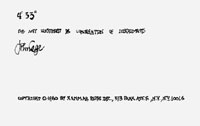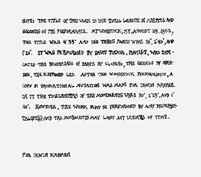Jarry, Joyce, Duchamp and Cage
The following essay is appearing for the first time in English. An Italian version appeared in the Catalogue for the 1993 Venice Biennale. The three-part fragmented format was due to my underestimating or misconstruing the publisher’s desires regarding length.
A little way into Part II of Goethe’s Faust, a short, cacophonous scene transpires in which various poets – poets of nature, court poets, love poets – are so intent on being heard that not a word can be understood by the audience. One poet, the Satirical Poet, does manage at last to get a decipherable word in above the din – it’s his only line in the play: “Do you know what would really delight me as a poet? To write and recite what no one wants to hear.”
With this one line, Goethe telegraphed with marvelous accuracy one of the most conspicuous features of the twentieth century avant-garde. I am thinking particularly of the work of three related giants: James Joyce, Marcel Duchamp and John Cage.
Never before has a work of literature been so universally known by name yet so little read as Joyce’s Finnegans Wake. Similarly, there is no precedent for a body of artwork so widely disseminated yet so little understood as Duchamp’s oeuvre from 1913 on. And in John Cage we have a composer who, even before his death, was being cited as the most influential composer of the twentieth century. Yet how many music lovers rush home from the record store to put on the latest Cage CD? It then comes as no surprise that Joyce was Cage’s favorite contemporary writer, Finnegans Wake his favorite work of twentieth century literature, and Duchamp his favorite artist.
Goethe’s Faust was admired and gleefully plundered by the eccentric French poet and playwright, Alfred Jarry. His extended take-off, Faustroll, contains stream of consciousness passages, which look forward to Joyce’s Ulysses, and numerous invented words, which help prepare us for Finnegans Wake.(1)
Faustroll is, on the whole, a work of such complexity that Jarry added these words to the completed manuscript: “This book will not be published integrally until the author has acquired sufficient experience to savor all its beauties in full.” In fact, Faustroll, was not published until 1911, four years after Jarry’s death at the pitiable age of thirty-four.
As Jarry was informed by Goethe’s sentiments, Joyce, Duchamp and Cage were informed by Jarry’s (Joyce and Duchamp, I believe, directly; Cage, according to my thesis, more by his love of Joyce and Duchamp). John Cage did not enjoy what he knew of Jarry. When I broached the subject, Cage said the following:
I have an allergy, you might call it, against the kind of expression that was Jarry’s, but it’s clear that Duchamp did not. But I agree with the view that everyone was influenced by Jarry. I myself think that Duchamp and Joyce having used Jarry is far more interesting than anything Jarry himself did.(2)
I never learned exactly how much of Jarry John Cage had read, but he admitted that he had read some. In 1989, at his suggestion, I loaned him my copy of the English translation of The Supermale.(3)
I had noted on the blank pages numerous passages which correspond with parts of Duchamp’s notes and with sections of Ulysses and Finnegans Wake. After a few days Cage returned the book, sayingthat it was a novel and he couldn’t read novels. A short time after thishe volunteered that my interest in the subject had brought him back to Jarry. Cage gave no titles and never indicated that his “allergy” had left him. I believe that if he had read more of Jarry, Faustroll in particular, his feelings might have changed. After all, in addition to his love for Joyce and Duchamp, who he agreed were influenced by Jarry,he repeatedly commented that he followed Antonin Artaud’s philosophy of theater. Artaud was, in fact, such a disciple of the writer that he named his theater “The Alfred Jarry.”
Ironically, John Cage had more similarities with Jarry than did either Joyce or Duchamp. His sexual orientation was much closer to Jarry’s than to that of the other two, although he was as soft-spoken on the subject as Jarry was blaring. And Cage, like Jarry, was an avowed anarchist. Here, too, the difference was more in the manner of expression and emphasis than in the bottom line commitment. But perhaps the most significant parallel between the two reveals itself when we look at their respective interest in Chance. We know that Cage studied with the Zen teacher, Daisetz Suzuki, and that as a result he started to use chance operations in his compositions around 1950.
Jarry was equally involved with Chance. His Pataphysics, an alternate hypothesis for the workings of the universe, assigns an important role to l’accident. The same holds true when he writes of matters à l’amour: “Men and women think they choose each other…as though the Earth should boast of revolving on purpose! It is in this passive inevitability, as of a falling stone, which men and women call love.” This “falling stone” remark may well have planted a seed in Duchamp which
resulted in the Standard Stoppages, by which he hoped to create “a new image of the unit of length.” The Jarry line which follows the “falling stone” reference runs: “The god and goddess are about to unite…in order to meet, they need a length of time which, according to human measurements,
varies between a second and two hours.” While this touches on the measurement of time, elsewhere (in How to Build a Time Machine) Jarry states bluntly that “space and time are commensurate.” He goes on to share his reasoning: “To explore the universe by seeking knowledge of points in Space can be accomplished only through Time: and in order to measure Time quantitatively we refer to Space intervals on the dial of a chronometer.”
Tapping another Jarry source, I have written:(4)
click to enlarge
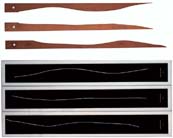
Marcel Duchamp,3 Standard
Stoppages, 1913-14
© 2000 Succession Marcel Duchamp
ARS, N.Y./ADAGP, Paris.
Jarry’s Doctor Faustroll has an almost obsessional fascination with standards of measure. He carries in his pocket a “centimeter, an authentic copy in brass of the traditional standard,”
and he also possesses a tuning fork, its period “carefully determined…in terms of mean seconds.” These habits are a parody of traditional Western science, which Jarry anarchically undermined. Discussing science, he remarked, “Universal assent is…a quite miraculous and incomprehensible prejudice.” Duchamp shared this attitude. The 3 Standard Stoppages, for example, in which the artist believed he had “trapped the mainstream of [his] future,” reflects his mock-scientific intention “to create a new image of the unit of length,” and to obtain a specimen of “canned chance.” The very method of their making – “a thread one meter long [falling] straight from a height of one meter on to a horizontal plane twisting as it pleases” – recalls a line in Jarry: “When a piece of copper is dropped…it will float down slowly as though a viscous liquid occupied the space.”(5)
There are many passages in each of his major works in which Jarry reveals strong feelings about chance. One description in The Supermale is particularly apt. The Supermale (Marcueil) wants to get into his disguise for the 82 ravishments of Ellen Elson within 24 hours.”It was ten o’clock, and André Marcueil was looking for an excuse to slip off to make way for the Indian. Chance – or perhaps some previously determined assistance brought about by chance – supplied him with one.” In Duchamp’s notes pertaining to his making of the 3 Standard Stoppages, he almost literally describes a previously determined assistance brought about by chance.
André Breton maintained that “beginning with Jarry…the differentiation long considered necessary between art and life has been challenged to wind up annihilated as a principle.” Duchamp presented manufactured products from life as art, a gesture surely in tune with this stance of
Jarry’s. And Cage’s composition 4’33”,
in which the natural sounds occurring during that length of time constitute the piece, likewise demolishes this distinction. Cage often said that 4’33” was his favorite of his own works, and that he believed that the most beautiful music was the natural sounds around us.(6)
click images to enlarge
-
John Cage,
4’33”, 1960
Reproduced with permission of
Henmor Press, Inc. New York -
John Cage,
4’33”, 1960
Reproduced with permission of
Henmor Press, Inc. New York
click images to enlarge
-
John Cage,4’33”, 1960
Reproduced with permission of
Henmor Press, Inc. New York -
John Cage,4’33”, 1960
Reproduced with permission of
Henmor Press, Inc. New York
The characters in Jarry’s Faustroll parody and, at times, ridicule Jarry’s great model, Goethe’s Faust. Duchamp’s improvised mustache performs a similar service for Leonardo’s La Gioconda. And so it is also with the vocalists in Cage’s Europeras 1,2,3,4 & 5, who are instructed to perform arias of their own choosing simultaneously with chance chosen excerpts, both orchestral and vocal, from existing masterworks. For a lover of Mozart or Monteverdi to hear a beloved aria overlaid with the sounds of a frothy bit of pastry from a popular operetta, the experience can readily be compared to that of an aficionado of Da Vinci’s works first encountering Duchamp’s desecrated icon,
click to enlarge
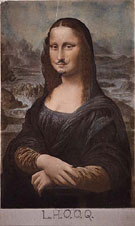
Marcel Duchamp,>L.H.O.O.Q., 1919
© 2000 Succession Marcel Duchamp ARS, N.Y./ADAGP, Paris.
L.H.O.O.Q.
There is a passage in Faustroll in which Jarry pokes such delicious fun at painters that I believe its publication in 1911 may have helped Duchamp decide to call it a day at the easel. In it, Jarry likens painting to masturbation, an urge so strong and irrepressible that there will be painting even after the end of the living world. Once again, Chance plays an important part in his fantasy:
When Jarry attacks the scientific rationale, he concludes by putting forth “purely accidental phenomena” as the more realistic explanation: “the laws which it is believed have been discovered in the traditional universe [are but] correlations of exceptions…of purely accidental phenomena.”And l’accident occurs as a pivotal idea in his definition of Pataphysics, given here in a shortened version:
In the early 1980s, at a festival of new music in Venice, I attended numerous concerts with John Cage, sometimes several in a single day. I made the observation that when I was listening to anyone else’s music I could pick up echoes of Berg, Stravinsky, Webern, Bartok, Schoenberg, or whomever. But then something of his would be played and I was on my own. No traces of ideas from earlier composers could be heard. His music was full of ever-new sound and structure, guaranteed no doubt by his use
of chance. For all I knew, his music could have come from another world.His polite smile of agreement reminded me that his way of listening could not be further from mine; his whole approach was ahistorical.
Robert Rauschenberg has remarked that he likes to operate in the ever-narrowing gap between life and art. John Cage has responded that he’d rather collapse them both together. If we think of the radical freshness of the Europeras, in effect built from the bits and pieces of the old – its debris you might say – Jarry’s introduction to Ubu Enchained, with which he greeted the last century in 1900, seems to be at least indicated, if not vindicated:
Pa Ubu: “Hornstrumpet! We shall not have succeeded in demolishing everything unless we demolish the ruins as well. But the only way I can see of doing that is to use them to put up a lot of fine, well-designed buildings.”(7)
© 1993, 2000 William Anastasi
*******************
April 24, 1993
A short time after John Cage learned that I was researching correspondences between Jarry’s writings and Duchamp’s notes and art works, he asked, “What have you found?” I listed some of the pieces by Duchamp, which seemed most clearly connected to certain passages or images in Jarry.
This list included:
The Large Glass, Étant Donnés, Bicycle Wheel, Bottle Dryer, In Advance of the Broken Arm, Tu m’, To Be Looked At With One Eye…, Monte Carlo Bond, L.H.O.O.Q., Why Not Sneeze Rrose Sélavy?, Comb, With Hidden Noise, Apolinère Enameled, Traveler’s Folding Item, Fountain and With My Tongue In My Cheek.
When I paused, trying to remember additional items, he asked whether I had found anything in Jarry, which might have pointed toward Duchamp’s “musical sculpture” paragraph, which is in the Green Box notes. [“Muscial sculpture. Sounds lasting and leaving from different places and forming a sounding sculpture which lasts.”] I answered that I had found a possible link in The Supermale, which was perhaps a less literal and certainly a more complex connection than the links I had been finding for many of the art works.
The images which make up this connection appear in a section of the novel in which suddenly a wide variety of sounds are being described for us at every turn. In some cases, sounds emanating from different places at different times are described as arriving intermingled at one place. Repeatedly we are given descriptions of three-dimensional objects giving off sounds – “sound sculptures,” if you will. The sound images include “the clicking of heels,” “a burst of laughter,” “a crystalline chatter…like parakeets, deliciously out of tune, like the sound of love instruments tuning up,” “a rustling sound,” “a light and rapid step [is heard],” “the beating of [one girl’s] little fists” as she “drums” on an ironbound door,a voluminous quarter-hourly clock-chime, while “downstairs…violins weretuning up,” etc. Making reference to the clock-chimes which punctuate the entire section, or rather the space of silence between them, he writes, “It was one o’clock, it was any time, then it was eleven o’clock in the evening, and the distant music struck through the silence as confusedly as nervous fingers straining after the eye of a needle.” Since a church’s spire with quarter-hourly chimes pouring forth could very aptly be described as a “sounding sculpture,” the following passage seems relevant: “…at
irregular intervals the highest notes of the top strings rose like spires piercing through the fog.” These high notes, we are told, are interspersed with the deafening chimes and other sounds, helping the reader to imagine a veritable concerto performed by three-dimensional objects: “…its booming filled the long room, the chandelier vibrated, the picture frames trembled, and near the ceiling, a pane of glass vibrated.” Jarry, who Breton tells us annihilated the difference between life and art, often describes natural sounds in pointedly musical terms. For example, in a passage already partially quoted, Jarry describes the sound of seven harlots gossiping as “crystallinechatter, deliciously out of tune, like the sound of love instruments tuning up, one might imagine.” Jarry is not only comparing their “chatter” to the sounds of musical instruments – he is also telling us that as prostitutes, they themselves are “love instruments” to be played, obviously, by their customers. In Faustroll he describes “stones [which] are as cold as the cry of trumpets,” contrasting them with others which have “the precipitated heat of the surface of kettledrums.”
I paused after having given John Cage a precis of the above, thinking there might be a response. When none came, I went on to describe a more direct connection between another passage in Jarry and a Duchamp note. It was not about a piece of Duchamp’s, but rather about one of many component parts of a piece (The Large Glass). When Jarry first describes Doctor Faustroll’s raiment, he pictures for us “tiny little gray boots, with even layers of dust carefully preserved on them, at great expense, for many months past…” Duchamp, in the Green Box notes, wrote, “For the sieves in the glass – allow dust to fall on this part a dust of 3 or 4 months…” I pointed out that the idea of “sieves” itself may well have come from the same book of Jarry’s. Chapter six of Faustroll is titled Concerning the Doctor’s Boat, Which is a Sieve. The Doctor describes in minute and obsessive detail the magnificent seagoing properties of this bark, then ends by informing the reader that “we shall not be navigating on water but on dry land.” By coincidence or otherwise, Man Ray’s photograph of Duchamp’s Dust Raising
click to enlarge
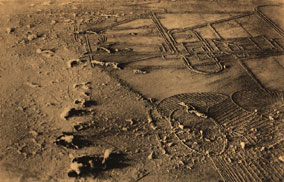
Dust Raising
by Man Ray and Marcel Duchamp, 1920
© 1960 Marcel Duchamp, George Heard Hamilton, Richard Hamilton
, reproduced on the page facing the Duchamp note in Richard Hamilton’s typographic version of the Green Box notes, which John Cage had by now opened in front of us, resembles, more than anything else, an aerial view of some extremely flat dry land.
I was emboldened to say that these connections, and a hundred others like them, left me with the impression that Duchamp, perhaps consciously, had been playing a game in which he used hints from Jarry’s writings in every major piece as well as in most of the lesser ones. Duchamp unfailingly left clues about the Jarry connection in the title, in the appearance, or in the accompanying notes of his work. At the same time, Duchamp unfailingly diverted attention elsewhere whenever an interview or conversation seemed headed in that direction.(8)
Again there was no response for some time. Then John Cage said, “Well, he was a wonderful man and I was extremely fond of him, but he did love secrets.”
Thinking of this remark, it has occurred to me that John Cage’s well-known openness is 180 degrees away from the stance of his friend. Cage, in addenda to his compositions, to his etchings or drawings, and even to many of his written works, took great pains to lovingly describe his methods in whatever detail necessary to attain the greatest clarity. Duchamp’s notes, by comparison, seem a maze of intentional obfuscation. I am aware of only one instance in which the artist left a document solely meant to illuminate. I am referring to the Manual of Instructions for the fabrication of Étant Donnés, revealed to the world after his death. And this manual was left for the excellent reason that without it there would have been no earthly way of assembling the intricately designed tableaux in the manner intended by the artist.
I once discussed this issue of artistic disclosure with John Cage. It was not in regard to Duchamp per se, but rather in regard to an admirer of both Cage and Duchamp, – Jasper Johns, who at that time, according to certain remarks attributed to him, seemed to share Duchamp’s fondness for mystery. John Cage made light of the issue. “Oh, I think it’s just a question of personality,” he said.
*************
I asked Dorothea Tanning if she would read a new and unpublished essay I had written titled Who Broke the Glass, which presents evidence to support the argument that The Large Glass was not broken accidentally, as the world has been told, but intentionally by, or at
the behest of, the artist.(9)
Ms. Tanning, who with her late husband Max Ernst, knew Duchamp well, has been generous with her help and encouragement. Both she and Max Ernst were great lovers of Alfred Jarry, and since she and I also share a fondness for Joyce, we are never at a loss for conversation. When she had handed my essay back she said it had convinced her, and she showed me something she had written in the margin of the last page. It referred to Duchamp, and she said that I could use it in future writings with attribution, or without. It reads, “All is formulaic and calculated. This meticulous planning leaves nothing to chance, that force so often claimed by the artist.” (Emphasis Dorothea Tanning’s.)
Reading this I found myself thinking once again about the parallels and differences between Marcel Duchamp and his friend John Cage. They both claimed Chance as an assistant. But in Duchamp’s case, at least according to Ms. Tanning’s view, nothing could be further from the truth.
(10)
Years ago, wanting to test Duchamp’s commitment to chance I had tried his thread-dropping experiment for the 3 Standard Stoppages – canned chance, as he called it. Tirelessly, with a wide variety of thread materials and thickness, I followed his “instructions” as they appear in the Green Box notes. Not once did the results come close to those three gentle and elegant arcs that he permanentized as the stoppages. John Cage, honoring Duchamp, tried this same experiment in making some of his earliest etchings. His results were as far from Duchamp’s as mine were, and not surprisingly, just about identical to my results. We talked this over a number of times, wondering what could account for the difference.
I have by now come to the conclusion that when a man as intelligent as Duchamp, as elegantly articulate, civilized and gracious says, “Every word I tell you is stupid and false”, and, “All in all I’m a pseudo, that’s my characteristic” – when he gives us one self-portrait titled With My Tongue In My Cheek, another as a wanted felon, a third as an old whore, and a fourth as the very devil – the net effect on most observers is to cause them to believe his every word, perhaps more than they might have had he never brought up the subject. It seems as though Duchamp managed to hide very well behind these statements and shady personas. Maybe most of us have difficulty believing that a man
of such genius and elegance would be capable of doing something so expected, so unimaginative, as to be telling the truth when he calls himself a liar. It is easier to believe that the disclaimers themselves were part of a game, a put-on, an act – that the real Duchamp was as straightforward as his famous profile.
John Cage and Marcel Duchamp can be seen then as being equally guilty of saying what they mean and meaning what they say. Duchamp, again and again, in a spectacular assortment of gestures, warned us not to take him too seriously. John Cage was fond of saying that a thing is what it is and his favorite of his own works accepts whatever sounds occur. In his life as in his art, Cage had not the slightest use for secrets, a fact which characteristically did not in the least prevent him from loving
and admiring the very artist who, above all others, thrived on them.
© 1993, 2000 William Anastasi
Notes
 1. According to my reading of Finnegans Wake, Joyce refers to Alfred Jarry as “me innerman monophone” and “me altar’s ego in miniature,” and retells or recalls various scenes from the life, as well as from every novel and theater piece, of the French author. In addition, one of the book’s four main characters, Shem (a.k.a. Jerry), is based in the largest part on Jarry himself.
1. According to my reading of Finnegans Wake, Joyce refers to Alfred Jarry as “me innerman monophone” and “me altar’s ego in miniature,” and retells or recalls various scenes from the life, as well as from every novel and theater piece, of the French author. In addition, one of the book’s four main characters, Shem (a.k.a. Jerry), is based in the largest part on Jarry himself.
 2. Speaking of Duchamp and himself, Cage said, “I think the difference between our attitudes towards chance probably came from the fact that he was involved with ideas through seeing, and I was involved through hearing.” Similarly, Jarry’s “…one has only to look” sets off Cage’s “One has only to listen.”
2. Speaking of Duchamp and himself, Cage said, “I think the difference between our attitudes towards chance probably came from the fact that he was involved with ideas through seeing, and I was involved through hearing.” Similarly, Jarry’s “…one has only to look” sets off Cage’s “One has only to listen.”
 3. Translated from the French by Ralph Gladstone and Barbara Wright, New Directions Pub., NY, 1977.
3. Translated from the French by Ralph Gladstone and Barbara Wright, New Directions Pub., NY, 1977.
 4. From William Anastasi, “Duchamp on the Jarry Road”, Artforum (September, 1991).
4. From William Anastasi, “Duchamp on the Jarry Road”, Artforum (September, 1991).
 5. John Cage, referring to the 3 Standard Stoppages, made the observation to Duchamp that when he, Cage, was two years old, the artist was already using chance. And on a number of occasions Cage said that this was his favorite of Duchamp’s entire oeuvre.
5. John Cage, referring to the 3 Standard Stoppages, made the observation to Duchamp that when he, Cage, was two years old, the artist was already using chance. And on a number of occasions Cage said that this was his favorite of Duchamp’s entire oeuvre.
 6. In 1975, Cage said, “All of my music since [4’33”] I try to think of as something which doesn’t fundamentally interrupt that piece.”
6. In 1975, Cage said, “All of my music since [4’33”] I try to think of as something which doesn’t fundamentally interrupt that piece.”
 7. Pére Ubu: Cornegidouille! Nous n’aurons point tout démoli si nous ne démolissons même les ruines! Or je n’y vois d’autre moyen que d’en équilibrer de beaux edifices bien ordonnés.
7. Pére Ubu: Cornegidouille! Nous n’aurons point tout démoli si nous ne démolissons même les ruines! Or je n’y vois d’autre moyen que d’en équilibrer de beaux edifices bien ordonnés.
 8.I have since come across a half dozen or so instances in which Duchamp either brought up Jarry for praise or, in response to questions about Dada, praised “his spirit” – once going so far as to call him “a great man.” I have yet to learn of a case in which someone else brings up the subject and Duchamp chimes in.
8.I have since come across a half dozen or so instances in which Duchamp either brought up Jarry for praise or, in response to questions about Dada, praised “his spirit” – once going so far as to call him “a great man.” I have yet to learn of a case in which someone else brings up the subject and Duchamp chimes in.
 9. A recent expanded version of this article has since been published in this journal under the title Alfred Jarry and l’accident of Duchamp, December 1999.
9. A recent expanded version of this article has since been published in this journal under the title Alfred Jarry and l’accident of Duchamp, December 1999.
 10. I have discovered at least one instance in which Duchamp seems clearly to have been guided by chance. In the early nineties I visited Duchamp’s friend and sometime collaborator the painter Enrico Donati. It was he who had been commissioned by Duchamp to execute a roomful of “pink foam-rubber breasts” (a readymade taken from a set of “falsies” which Duchamp had designed for the cover of the catalogue to the Paris exhibition Le Surréalisme en 1947). Donati told of having covered his studio floor with these delights for Duchamp’s first viewing. Duchamp entered the room and for a spell no one spoke. Finally, to end the silence, Donati said, “Please touch.” Without missing a beat, Duchamp turned to him with pointing finger and said, “That’s the title.” Perhaps Arturo Schwarz was unaware of this exchange. Regarding “Please touch” he writes, “Whether this request arises from the Bride’s desire or the bachelor’s wishful thinking, the result is the same.” (The Complete Works of Marcel Duchamp, 1997 p. 228) It would seem that it rose, in fact, from Donati’s off-handed icebreaker and Duchamp’s relaxed suggestibility.
10. I have discovered at least one instance in which Duchamp seems clearly to have been guided by chance. In the early nineties I visited Duchamp’s friend and sometime collaborator the painter Enrico Donati. It was he who had been commissioned by Duchamp to execute a roomful of “pink foam-rubber breasts” (a readymade taken from a set of “falsies” which Duchamp had designed for the cover of the catalogue to the Paris exhibition Le Surréalisme en 1947). Donati told of having covered his studio floor with these delights for Duchamp’s first viewing. Duchamp entered the room and for a spell no one spoke. Finally, to end the silence, Donati said, “Please touch.” Without missing a beat, Duchamp turned to him with pointing finger and said, “That’s the title.” Perhaps Arturo Schwarz was unaware of this exchange. Regarding “Please touch” he writes, “Whether this request arises from the Bride’s desire or the bachelor’s wishful thinking, the result is the same.” (The Complete Works of Marcel Duchamp, 1997 p. 228) It would seem that it rose, in fact, from Donati’s off-handed icebreaker and Duchamp’s relaxed suggestibility.

